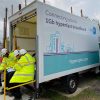North Yorkshire UK Completes Phase 1 Superfast Broadband Rollout
The Superfast North Yorkshire project in England, which had been working with BT to make “fibre broadband” (FTTC/P) services available to 90% of local premises by the end of 2014 (86% for “superfast” speeds of 24Mbps+), has finally completed its first major deployment phase.. albeit seemingly somewhat later than planned.
Overall the phase 1 Broadband Delivery UK scheme, which was funded by £10m from BT, £17.8m from BDUK and £8.6m from the EU, has helped to put an additional 150,000 local homes and businesses in “non-commercial areas” within reach of the “fibre broadband” network (total coverage of 380,000 premises when you add BT’s commercial deployment). It’s noted that 34,000+ premises within the project area have also signed-up to the service.
Advertisement
The 1000th and final Street Cabinet went live in the small market town of Masham, which compliments the 10,000 kilometres of new fibre optic cable that has been laid and the 149 telephone exchanges which have so far been upgraded as part of the programme.
Scott Walters, CEO of SFNY, said:
“The completion of the main part of the Superfast North Yorkshire project is fantastic news and means that hundreds of thousands of homes and businesses who were previously beyond the reach of fibre, can now enjoy the numerous benefits of high speed broadband.”
The good news is that North Yorkshire were also one of the first BDUK schemes to last year sign an £8m+ Phase 2 Superfast Extension Programme (SEP) contract, which will benefit an additional 11,000+ premises and push “superfast broadband” coverage to 90% of the county by late 2016. Work on that is already underway.
However Phase 2 will still leave approximately 10% (40,000 properties) without access to fibre-based superfast broadband and so preliminary work is also underway to develop a Phase 3 plan for delivering “high quality broadband” to 100% of the county (we note that they don’t use the word “superfast” for this), which should complete by the end of 2017.
But the Government’s BDUK programme has yet to allocate any funding for Phase 3, although SFNY hasn’t used all of its allocated Phase 2 funding and so the flexibility is already there if they can find a way to match it.
Advertisement
Mark is a professional technology writer, IT consultant and computer engineer from Dorset (England), he also founded ISPreview in 1999 and enjoys analysing the latest telecoms and broadband developments. Find me on X (Twitter), Mastodon, Facebook, BlueSky, Threads.net and Linkedin.
« Big UK Internet Providers Forced to Block 7 Pirate eBook Websites
The March 2015 BDUK and BT “Fibre Broadband” Uptake Figures »


















































Comments are closed